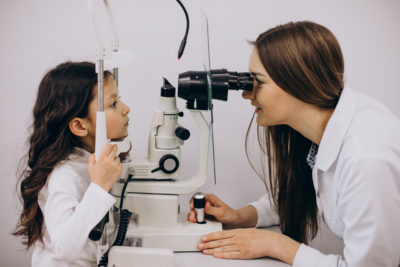The other day we met Anuj, an 11-year-old schoolboy. As he entered the hospital, his joyous smile and calm demeanour made every head turn. While he was right sitting next to his parents playing with his toy car, we learned that he suffered from strabismus eye, a condition where one eye is turned in a direction different from the other eye.
Since we have been in the medical field for about sixty years, we have met several young patients of different age groups. Therefore, we understand that it is essential to put both the child and the parents at ease before we begin the process of thorough diagnosis and treatment. In an attempt to start a friendly conversation, we asked Anuj about his interests and hobbies.
He spoke about his love for football excitedly and how he is appreciated for his technique and approach by his coaches in school. However, due to cross-eyes, he faces several complications like headaches, double vision, lazy eye, eye strain, blurry vision etc., which keeps him from participating in his school competitions. In a relaxed tone, we told him that his eye condition is called strabismus and assured him that there is nothing to worry about since it is easily treatable.
After about half-hour, we spoke with Anuj’s parents and gave them a brief yet comprehensive insight into strabismus eye, types of strabismus, and all the available treatments for cross-eyes that are tried and tested over year. Also, in addition to all the complications that Anuj has been facing, we mentioned other symptoms/complications of cross-eyes like:
- Difficulty in reading.
- Inability to move both together.
- Shutting one eye while looking at faraway objects.
- Closing one eye or squinting under bright sunlight
- Turning or tilting the head to look at a person or an object.
- In some cases, it can also lead to loss of vision in the misaligned eye (amblyopia)
- Since strabismus eye limits depth perception, patients unknowingly bump into things or people.
Types of Strabismus Eye: An Overview
Before beginning with the treatment for cross-eyes , we spoke in length with Anuj’s parents about types of strabismus eyes and how they are different from one another. Below we have brought under purview two primary types of strabismus recognized by doctors and surgeons in the field of ophthalmology:
- Convergent Squint
Strabismus eye, also referred to as squint, is misalignment where eyes struggle to look in the same line or direction. Additionally, in this type of cross-eyes, the misaligned eye is directed towards the nose. In medical terms, this condition is called Esotropia.
There are multiple causes of convergent strabismus eye like hereditary, diabetes, premature birth, neurological disorders, overactive thyroid, untreated far-sightedness, etc. However, this type of strabismus can also be segregated into congenial, refractive, acute, sensory, and incomitant Esotropia that can be treated by surgeries, Botox injections, glass prescriptions, and more.
- Paralytic Squint
In simple terms, the inability of the eye to move due to muscle paralysis leads to a condition called paralytic squint. Vertigo, giddiness, double vision, tilting/turning head for better eye positioning are some of the many symptoms of paralytic strabismus.
The causes of this type of strabismus eye can vary from trauma, stroke, and tumours to hypertension and diabetes. With extensive research and upgraded ophthalmological technology, this condition can be treated by Botox injections, prism glasses, and eye muscle surgery.
Available Treatments for Strabismus
After a thorough discussion, Anuj’s parents booked an appointment to visit us again the next day for a formal diagnosis. We noted Anuj’s other general health problems and proceeded with the visual acuity, which includes reading from an eye chart. Next, we conducted some focus and alignment tests for squints and presented a list of eye treatment options like:
- Contact lenses or Eyeglasses: Generally, these are used in patients with refractive errors. However, with the use of corrective lenses, the eyes require less focusing effort, broadening the possibility of remaining straight in the line of vision
- Eye Muscle Surgery: Surgery changes the position or the length of the eye muscle, which results in properly aligned eyes. This procedure takes place with the help of dissolvable stitches and general anaesthesia to make the patient more relaxed and comfortable.
- Prism Lenses: These are special lenses that are capable of bending the light entering the eye. With the help of these lenses, the patient does not have to keep tilting their head to look at objects that do not fall in their line of vision.
- Medications: Along with ointments and eye drops, injections of botulinum type A, like Botox, can successfully weaken an overactive eye muscle. These oral treatments can be used in place of surgeries, depending on the patient’s situation.
Since Anuj’s case was severe, we suggested that an eye muscle surgery should be an ideal solution to fix his cross. Initially, our recommendation was met with hesitation and reluctance, but once we assured his patients of a safe and reliable process, they agreed.
The other day, Anuj visited us after seven weeks of recovery period post the surgery. When we asked him how he was feeling, he ecstatically spoke about his plans to be a part of his school football team and auditioning for a drama group.
Most strabismus eye patients suffer from low self-esteem and self-confidence. A simple corrective surgery can make a huge difference in the way a person feels about themselves, especially at a tender age. By the end of his last consultation session, we wished Anuj a happy and successful life with a smile and a promise to win gold for his school.
Dr Agarwals Eye Hospital: Acing in the Field of Ophthalmology Since 1957
At Dr Agarwals Eye Hospital, we aim to be a one-stop destination for all eye-related problems. With an expansive team of highly skilled eye doctors and surgeons across 11 countries, we provide safe and reliable treatments for eye diseases conditions like strabismus eye, diabetic retinopathy, cataract, glaucoma, retinal detachment, and more.
We combine innovation, experience, and exceptional knowledge with best-in-class ophthalmic technology to offer complete eye care across diverse specialities. In addition, with a world-class technical team, unmatched hospital experience, and well-trained staff, we have maintained an edge in the medical sector by providing finest treatments like PDEK, glued IOL, oculoplasty, and more.
Learn more about our medical treatment and services by exploring our website today!
Sources:
- What-is-diabetes – https://www.niddk.nih.gov/health-information/diabetes/overview/what-is-diabetes









